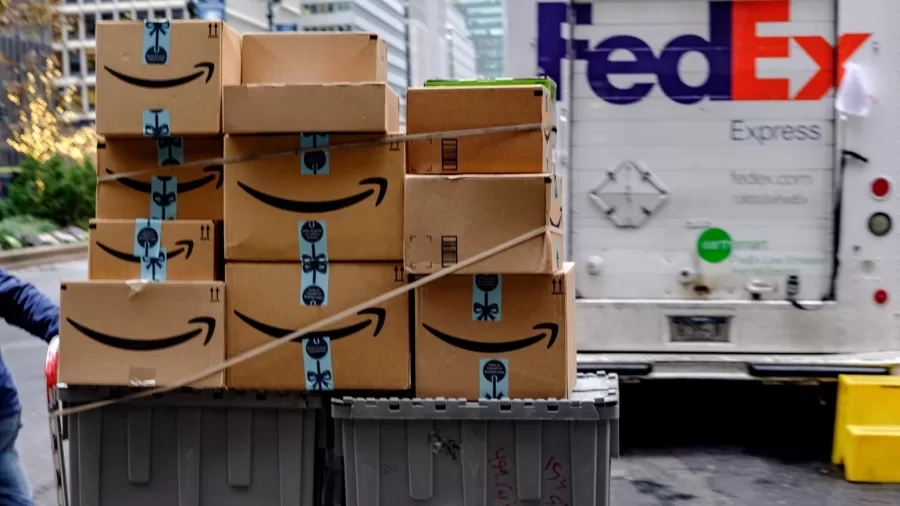Business
Amazon Switches Gears: FedEx Steps In as UPS Bows Out

- Amazon shipped 6.3 billion packages in the U.S. in 2024, surpassing both FedEx (3.1B) and UPS (4.7B), and is now partnering with FedEx to fill the delivery gap created by UPS’s pullback.
- FedEx signed a multi-year deal with Amazon on May 10, 2025, to handle large residential packages, signalling a significant realignment in e-commerce logistics and carrier relationships.
A Pivot With Purpose
Amazon just made a quiet but meaningful move.
On May 10, 2025, the company announced a multi-year partnership with FedEx, marking a return to collaboration after a five-year separation.
After years of building one of the largest logistics networks in the world—and parting ways with FedEx in 2019—the e-commerce giant is now shaking hands with its former delivery rival.
This new partnership isn’t about repairing old ties. It’s about solving a capacity problem that’s been creeping up on Amazon since UPS started pulling back.
UPS, once Amazon’s top delivery partner, is scaling down its commitments. And by the end of 2026, Amazon’s volume through UPS will drop by more than half. That’s no small shift. Amazon had to respond—and fast.
So here we are.
Amazon and FedEx are back in business.
What You Should Know About the Brands
Amazon
You know Amazon as the everything store. But it’s just as much a logistics company as it is a retailer.
In 2024 alone, Amazon shipped over 6.3 billion parcels in the U.S., outpacing both FedEx and UPS. The only organisation with a higher volume was the U.S. Postal Service.
Amazon’s logistics operations span cargo planes, last-mile vans, regional sort centres, and a growing Extra Large (XL) delivery network that ships bulkier items like furniture, TVs, and fitness equipment.
That last piece—XL delivery—is where things started to bottleneck.
FedEx
FedEx, headquartered in Memphis, Tennessee, built its brand on speed, reliability, and global scale. For years, it was Amazon’s key delivery partner—until the companies parted ways in 2019, citing competition and capacity issues.
Since then, FedEx has focused on strengthening its commercial delivery services and expanding globally. But it hasn’t found a way to replace the volume it lost from Amazon.
Now, with Amazon’s need for more shipping muscle, FedEx has a way back in.
Why the Deal Happened Now
UPS is rethinking its priorities.
Instead of chasing high-volume, lower-margin deals, UPS is tightening its network. The company is laying off 20,000 employees and closing 73 facilities to boost profitability.
That leaves Amazon without a critical piece of its logistics puzzle. Especially for XL items, which need special handling and more delivery space.
This is where FedEx comes in.
According to internal Amazon documents, FedEx will handle a significant portion of Amazon’s XL residential deliveries. The deal is described as a multi-year agreement, and it’s more than just a band-aid.
It’s a strategic pivot for both companies.
What This Means for You (and the Market)
This deal is about more than just delivery trucks. It’s about branding, logistics influence, and consumer trust.
For Amazon
- Fills the capacity gap left by UPS
Amazon avoids delivery delays during peak shopping periods.
- Keeps Prime customers satisfied
Delayed delivery for XL items could lead to churn. This deal helps Amazon hold its service standards.
- Demonstrates operational flexibility
Amazon’s willingness to work with a former rival shows pragmatism over pride.
For FedEx
- Regains a massive source of shipping volume
After years of competing with Amazon, FedEx now gets a steady pipeline of high-volume business.
- Boosts investor confidence
FedEx shares jumped by 7% after the announcement, with clear market approval.
- Strengthens position in residential delivery
Residential drop-offs, especially for larger goods, have been harder to scale. This gives FedEx a stronger foothold.
A Reversal in Tone
Just five years ago, FedEx and Amazon seemed incompatible.
FedEx declined to renew its contract with Amazon in 2019, choosing instead to focus on other e-commerce players like Walmart and Target.
Amazon, in response, expanded its own fleet.
But the e-commerce landscape has changed.
Today, there’s a growing demand for flexible, scalable logistics—especially in categories like home goods, electronics, and fitness equipment. These aren’t products you can just toss into a delivery locker.
They require trucks with liftgates, scheduled drop-offs, and sometimes even white-glove installation.
This is where FedEx shines. And it’s where Amazon needed support.
The Bigger Picture
Logistics is no longer just about moving boxes. It’s now a brand differentiator.
Customers associate fast, reliable delivery with trust. Delays—even by a day—can erode confidence, especially in markets like the UK, Germany, and the U.S., where Prime membership expectations are high.
For Amazon, staying on top of delivery reliability is a business-critical metric.
FedEx now plays a role in that equation.
This move also signals a possible industry trend: more collaboration between rivals, driven by necessity.
Are we entering a phase where brand competition takes a backseat to operational efficiency?
Will we see Amazon rekindle other old relationships if it means better delivery outcomes?
Questions worth asking.
The Road Ahead
Neither Amazon nor FedEx have disclosed the financial terms of the deal. But industry insiders say the agreement is significant in scope and impact.
UPS, for its part, will focus on high-margin business and enterprise customers. It may win in profitability but lose ground in consumer mindshare.
Amazon will likely continue investing in its internal network. But this deal shows it’s not planning to go fully independent anytime soon.
FedEx gets a second chance to work with one of the world’s largest shippers.
And for consumers, the result could be faster, smoother deliveries—especially for the items that don’t fit in a regular box.



















































